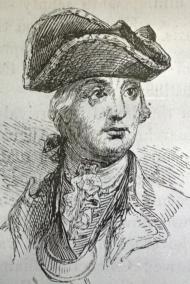
Major General Robert Howe Chapter
National Society Daughters of the American Revolution
Whiteville, North Carolina
Profile of Major General Robert Howe
(1732-1786)

Major General Robert Howe,
North Carolina’s highest
ranking officer during
the American Revolution.
Image courtesy of the State Archives
of North Carolina
Robert Howe was the highest ranking North Carolinian in the Continental Army. He was seventh in seniority among American generals during the Revolutionary War. That means that only six generals were ahead of him in rank and the Major General Robert Howe Chapter is justly proud to be named for him.
When the Revolutionary War was being instigated, Howe was involved. And after the war actually began, he was definitely a real patriot. From 1779 to 1783, he commanded a division under George Washington, who entrusted him again and again with sensitive, delicate missions. His most exciting experiences occurred when he was a commander in New York. He participated in the defense of the fort at West Point. He presided over the court martial of Benedict Arnold, perhaps the most famous traitor in early American history. Howe later sat on the jury for the spy trial of the British Major John Andre. After serving in the military, Howe returned to North Carolina and began to rebuild his image as a planter and political leader.
Major General Robert Howe was a very complex man. He was smart, clever, and brilliant in some ways but not in others. He was a fantastic military man and a respected member of the North Carolina legislature, but he had no practical sense when it came to business or to the managing his enormous rice plantation (over a thousand acres). Howe had inherited Kendal Plantation from his father. Howe’s plantation was just north of Orton Plantation, home of the Moore family. Information about his early life is sketchy, but we do know he was well-educated for his day. He had a love of Shakespeare and other major English writers. He had fluency with the English language and an air of polished breeding and confidence that was part of his general demeanor.
Young Robert Howe married Sarah Grange. They had one son also named Robert and six daughters: Anna, Rebecca, Mary, Rachel, Sarah, and Elizabeth. But the marriage didn’t last. In those days, divorce was not thinkable. So they obtained a “legal separation” in 1772. Howe’s wife lived at the Grange Farm.
After the war, he was elected to the North Carolina legislature but died on his way to Fayetteville where the legislature was meeting. He died at Point Repose, home of his friend, General Thomas Clark.
The Major General Robert Howe Chapter’s long-term objective is to find out where Howe is buried. In the 1960s several DAR members met with a representative of the paper company that now owns the land on the Cape Fear River where he may be buried. The company representative said that if we could prove that Howe’s grave was there, the company would give an appropriate section of the land for an historical park. The paper company made a road into the area about a fourth of a mile off the main road (Hwy 11) and the Major General Robert Howe Chapter DAR members put a wooden marker there. By now the road is likely grown up and the marker rotted away. If there were any graves there, the enormous erosion of the river bank has by now washed them into the Cape Fear River.
Notes from the files of Mary Wyche Mintz , Registrar. Submitted by Peggy Carr Yoder Blackmon, Regent. August 28, 2012.
Web hyperlinks to non-DAR sites are not the responsibility of the NSDAR, the state organizations, or individual DAR chapters.
